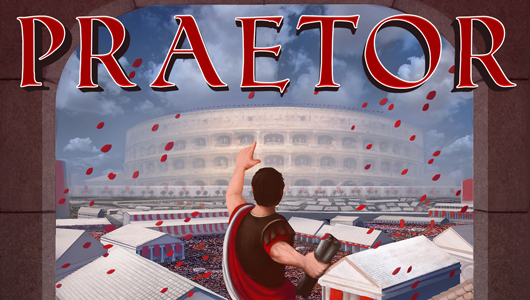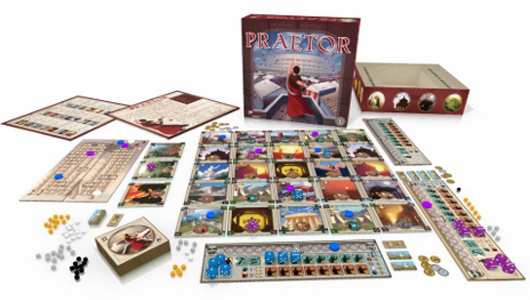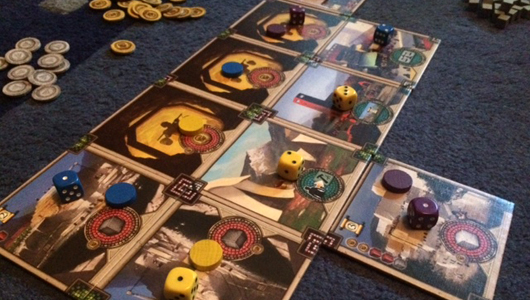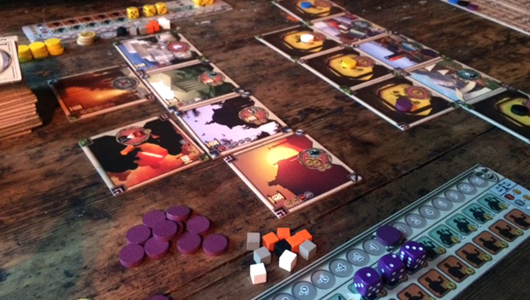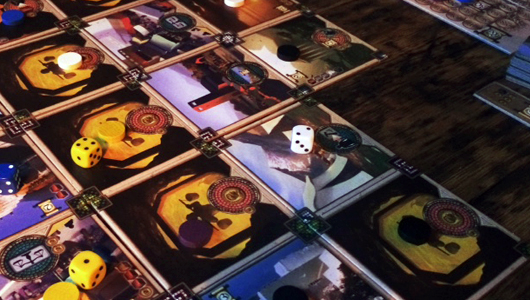Praetor is a worker placement game, where each player is an engineer in Roman Empire of 122 CE trying to impress Caesar Hadrian with their city planning skills. The player who does so and gains the most favour points is appointed Praetor to rule the Province in the name of Caesar and, as a small bonus, also wins the game.
I have played and reviewed a lot of worker placement games mainly because I love the core concept and the mechanics of those types of games. Their base elements really appeal to my play style. They have strategy, resource management and competitiveness, occasionally very intense competitiveness, and there is a lot of player involvement. Praetor ticks all those boxes but also has new interesting mechanics and twists on well-established worker placement concepts.
• Designer: Andrei Novac
• Publisher: NSKN Games
• Number of Players: 2- 5
• Playing Time: 75 min
The first interesting change from ‘standard’ is immediately obvious in the way the game deals with workers. Used to seeing meeples as the faithful minions fulfilling the tasks, I was surprised by their replacement in this game – die. The value on the dice represents the experience of your workers, which can be gained by either building city tiles or activating red powers on the tiles. Having experienced workers in your crew definitely proves beneficial as workers gain the amount of money and resources equal to their value.
However, workers also retire when they reach the value of six and become unable to perform their tasks. That is, unless you are very evil and activate a special power to make them work even in their tired wise age. However, no matter whether retired or active, every worker needs to be paid a salary at the end of each round. If you fail to pay wages, they will become unhappy and this will eventually cost you favour points. While it is always tempting to get a higher dice value for a better payoff, the game encourages the player to be mindful as the pool of dice is not endless and every active and retired worker is costing money each round – and money, another main resource in the game, is not that easy to come by.
In fact, the game nails the right balance between being overflown with resources and fighting to the death for them. While there are a few resource dedicated tiles (their number will vary depending on how many players are in the game), they are accessible, unless someone is already occupying the tile. The market tile is also very helpful as it allows as many transfers as the player needs: resource to money, and if need be, money to another resource.
In my previous reviews of worker placement games, I have highlighted that in my opinion, making tiles too accessible makes them less special and the game less competitive and interesting. Istanbul, was an example of the game that I believed suffered from too much freedom of roaming around the board. While in Praetor resource tiles and Mines (your source of gold) are easily accessible, in fact each player gets given their own Mine at the start of the game; there are a lot of other things to consider as well.
Resources and money are used to either build new city tiles or for completing wall tiles. Both actions also provide favour points. However, there are so many other ways to get favour points as well. There are tiles that give favour points for all active workers, or for the number of tiles the player owns and so on. On top of that, the player must remember to train their villagers so they can turn into active workers which is also a tile action.
The combination of all these possibilities encourages players to make very different decisions throughout the round. One player might need to train their villagers to have more active workers to perform more tasks next turn. While another player might desperately need to find a way to get more money to pay their workers. While yet another player needs to go to market to exchange money for weapons to afford a city tile on their next go. So while there could be several tiles on the board that do almost the same action, players tend to use them to reap different rewards and so each tile has a different weight of importance depending on what is happening at that time in the game.
Another important game mechanic is the way the player order is determined. The player with the most favour always goes last, and the player with the least favour – first. This is incredibly helpful, especially in the first rounds of the game where the last person is clearly at a disadvantage. By the time the order gets to them, the pool of available city tiles is either severely limited or exhausted all together, and even the best action spaces will be occupied. They will most probably get no, or very little, points at the end of the first round, but will start first on the second round and this time will have the first choice of actions. Due to this turn order, even if someone gets a big head start, they will not be impossible to catch up to. In fact, I would suggest trying to avoid getting ahead for the first several rounds of the game as it gets harder to get to good places when having your turn last.
Players build a city by laying down tiles. The position of the tiles does not affect how accessible they are – the workers could be sent all over the board and occupy any tile, as long as it has not already been taken. While technically, the tiles could be laid completely randomly and this would not affect the game, Praetor has a little helpful mechanic that might encourage players to put tiles in certain positions. There are little mosaic pieces on each corner of the tile and matching the same mosaics will earn players bonus points. While this is certainly secondary to the overall game mechanic, this helps to make the board less random and inform players’ choices.
Praetor has a lot going on: you build and activate tiles with different powers, train or retire workers, complete wall cards and there is a turn order to keep in mind. However, I would not say that the game is overly complicated to get into. Playing one or two rounds is enough to get into the swing of things, and tiles powers are easy to understand. What is hard, at least for the first few games, is to come up with one solid strategy for the game. I have found myself mostly reacting to what was happening on the board at the time. Sometimes this worked great, especially considering that the tiles that are available to build refresh every round. However, sometimes I felt a little bit overwhelmed and lacking direction. Should I get more resources hoping to be able to build a tile next round? Should I train a worker? Should I just get some more gold? I am sure that as I get better acquainted with tiles and get more experienced with the game, I will feel less lost, but Praetor is definitely a game that benefits from several playthroughs.
Praetor is really fun to play and I love that there is a variety in tile types and a good number of tiles to number of those type of tiles ratio. However, I also feel that the game drags on slightly. The official rules state that the game ends when the stack of available city or wall tiles runs out. As buying tiles is not a compulsory each round, it might take awhile to get through the whole stack. Closer to the end to the finish line, the game reaches a standstill feel. All the best tiles are already in play, and no one is rushing to buy new ones, and the players start to perform the combination of the same actions just to buff up on points. Once in a while someone will buy a new tile, if it is point worthy enough, but the overall the pace has already slowed down compared to the beginning of the game. The board has grown significantly and the players have so many possibilities that the urgency of taking that sweet spot is gone. The players start to loose attention. By no means is this a major complaint, but I know that the next time I play this game, I will let the number of rounds rather than the number of tiles determine the end of the game.
Finally, a few remarks on the look of the game – I have to confess that if I have seen the box on the shelf of the shop, I would probably not pick it up. It is probably the dirty and brown-ish colour scheme that puts me off, and the image of the Praetor in a standard Roman setting just looks a little bit dated and generic. Of course, one should not judge a board game by its game box! However, it is also true that things that look nice catch our attention more easily. As for the rest of the game I neither like nor dislike the art style. The artwork on the tiles is nice but not so interesting that I would spend time looking through them.
The game has a variety of pieces: standard cardboard ‘gold’ and ‘silver’ coins, different colour die for each player and matching colour player tokens, and, of course, the resources in the form of black, grey, white and orange cubes. There is also a scoring board and each player gets their individual player board. While the box’s interior is as simple as it can be, the game at least comes with the ample amount of plastic bags to package all the pieces separately.
Praetor is full of strategic decisions, competition, intense gaming moments and it is also very fun to play. The game occasionally loses its momentum and starts to drag on, especially towards the end, but it also has some great mechanics that allow for an interesting gameplay. I especially like how the game controls the play order, not allowing players to get so far ahead that they would be impossible to catch up with. While this might not be the prettiest game of my board game shelf, the artwork is not so important when the mechanics are good and solid, and Praetor definitely nails that!
Tags: Andrei Novac, Caesar, Istanbul, NSKN Games, Roman Empire, Worker placement

